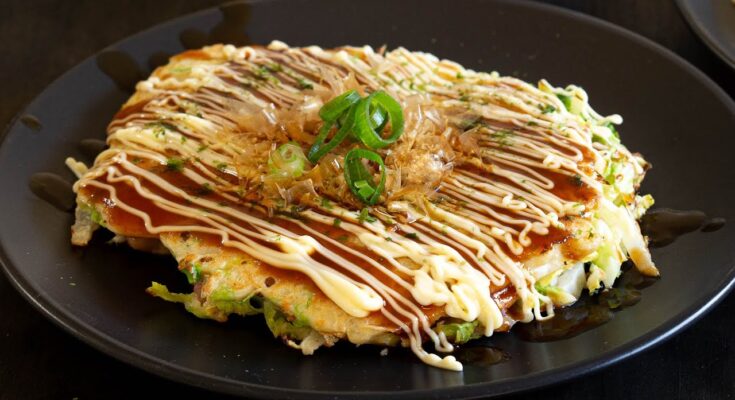Okonomiyaki Recipe: Okonomiyaki is one of Japan’s most beloved comfort foods, often referred to as a “Japanese savory pancake.” Its name, which loosely translates to “grill what you like,” perfectly captures the dish’s essence: a versatile, delicious creation tailored to your tastes.
Originating in Hiroshima and Osaka, Okonomiyaki has since become a staple across Japan and worldwide. Whether you’re a seasoned cook or a kitchen newbie, this step-by-step guide will help you master the art of making Okonomiyaki at home.
Ingredients Needed for Okonomiyaki
1. Essential Ingredients for a Traditional Okonomiyaki To create an authentic Okonomiyaki, you’ll need the following:
- Flour (Okonomiyaki flour preferred): This provides the pancake base. If unavailable, all-purpose flour works too.
- Dashi stock: A staple in Japanese cuisine, adding umami flavor.
- Eggs: They bind the batter together.
- Shredded cabbage: The heart of Okonomiyaki for texture and bulk.
- Protein options: Thinly sliced pork belly, shrimp, squid, or tofu.
2. Optional Ingredients to Customize Your Okonomiyaki
- Green onions
- Pickled ginger (beni shoga)
- Tempura flakes (tenkasu) for crunch
- Cheese for added richness
3. Ingredient Substitutions for Dietary Preferences
- Use gluten-free flour or rice flour for a gluten-free version.
- Replace dashi with vegetable stock for vegetarians.
- Swap pork with plant-based proteins like tempeh for a vegan twist.
Tools and Equipment
1. Tools You’ll Need for the Recipe
- A large mixing bowl for the batter.
- A whisk or fork for mixing.
- A flat spatula for flipping.
- A non-stick skillet or griddle for cooking.
2. Alternatives if Specific Tools Are Unavailable
- If you lack a spatula, use a wide fork or a flat-edged spoon.
- No griddle? A standard frying pan works just as well.
Step-by-Step Instructions
1. Preparing the Batter
- In a large bowl, combine 1 cup of flour with 3/4 cup of dashi stock.
- Whisk in two eggs until the batter is smooth and lump-free.
- Let the batter rest for 10-15 minutes to improve texture.
2. Adding Cabbage and Other Vegetables
- Finely shred half a medium cabbage (about 3 cups) and mix it into the batter.
- Optional: Add thinly sliced green onions or grated carrots for extra flavor and color.
3. Incorporating Protein Toppings
- If using pork belly, shrimp, or squid, cut them into bite-sized pieces.
- Fold the proteins into the batter or layer them directly on the pancake while cooking.
4. Cooking the Okonomiyaki on a Griddle or Skillet
- Heat your skillet or griddle to medium heat and lightly oil it.
- Pour one ladle of batter onto the skillet, spreading it into a round pancake about 1/2 inch thick.
- Cook for 4-5 minutes on one side until golden brown.
5. Flipping Techniques for an Intact Pancake
- Use two spatulas to gently flip the pancake in one motion.
- Cook the other side for another 4-5 minutes, pressing slightly with the spatula for even cooking.
6. Adding the Finishing Touches
- Once cooked, transfer the Okonomiyaki to a plate.
- Generously drizzle Okonomiyaki sauce and Japanese mayonnaise on top.
- Sprinkle with bonito flakes, aonori (seaweed powder), and pickled ginger for garnish.
Tips and Tricks for Perfect Okonomiyaki
1. Common Mistakes and How to Avoid Them
Even the most straightforward recipes can have their pitfalls. Here’s how to dodge them:
- Overmixing the batter: This can make your Okonomiyaki dense instead of fluffy. Mix just enough to combine the ingredients.
- Using too much oil: Excessive oil can cause your pancake to become greasy. A light coating on the pan is enough.
- Cooking on high heat: High heat might burn the outside while leaving the inside undercooked. Medium heat ensures even cooking.
2. How to Achieve the Ideal Texture and Flavor Balance
- For a crispy exterior, press the pancake slightly while cooking and allow enough time for each side to brown.
- Balance the toppings—don’t overload the pancake, as it can make flipping difficult and cooking uneven.
- Ensure the cabbage is shredded finely to integrate well into the batter for a perfect bite every time.
Serving Suggestions
1. Pairing Okonomiyaki with Side Dishes
Okonomiyaki is a satisfying meal on its own, but pairing it with the right sides enhances the dining experience:
- Miso soup: A light and warming addition.
- Japanese pickles: Add crunch and acidity to balance the flavors.
- Edamame: A simple and nutritious complement.
2. Drinks to Complement Your Meal
The savory richness of Okonomiyaki pairs well with:
- Green tea: For a refreshing palate cleanser.
- Beer or sake: If you’re indulging in an adult beverage.
- Soft drinks: A sweet carbonated drink works surprisingly well with the umami flavors.
FAQs about Okonomiyaki Recipe
What is Okonomiyaki?
Okonomiyaki is a popular Japanese savory pancake containing a variety of ingredients. The name is derived from “okonomi,” meaning “what you like,” and “yaki,” which means “grilled” or “cooked.” This dish is customizable and typically includes cabbage, flour, eggs, and a choice of protein like shrimp, pork, or octopus.
What are the key ingredients in Okonomiyaki?
The basic ingredients for Okonomiyaki are flour, water or dashi, eggs, cabbage, and green onions. You can add various toppings and mix-ins such as pork belly, seafood, cheese, and vegetables, depending on your preference.
How do you make Okonomiyaki sauce?
Okonomiyaki sauce can be made by mixing together Worcestershire sauce, ketchup, soy sauce, and a sweetener like honey or sugar. This blend creates a thick, tangy sauce perfect for drizzling over the pancake.
Is Okonomiyaki healthy?
Okonomiyaki can be considered a balanced meal as it contains vegetables, protein, and carbohydrates. However, the healthiness can vary depending on the types of ingredients and the amount of oil used for cooking. Using lean meats and minimal oil can help in making it a healthier option.
Can Okonomiyaki be made vegetarian?
Absolutely! For a vegetarian version, simply omit the meat and seafood and add more vegetables like bell peppers, mushrooms, and zucchini. You can also incorporate tofu as a protein substitute.
How do you flip Okonomiyaki?
Flipping Okonomiyaki can be tricky due to its size and consistency. It’s best to use two wide spatulas to support the pancake fully. Carefully slide the spatulas under from opposite sides, lift gently, and flip it over in one smooth motion.
Can Okonomiyaki be made ahead of time?
While best served fresh, you can prepare the batter and chop the ingredients ahead of time. Store them separately in the refrigerator, and when ready to eat, mix the ingredients into the batter and cook the pancakes.
Conclusion
Making Okonomiyaki at home is a delightful culinary adventure that brings a taste of Japan to your kitchen. With its rich flavors, crispy textures, and customizable ingredients, this savory pancake is sure to impress your taste buds. By following this step-by-step guide, you’ll master the art of crafting the perfect Okonomiyaki that’s both delicious and visually appealing. So, roll up your sleeves, gather your ingredients, and get ready to savor this iconic Japanese dish.



